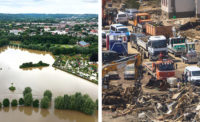Viewpoint
Got AI? You'll Need It as Climate Change Worsens Flood Risk

Atmospheric rivers in California this winter caused major flooding and land movement such as in Rancho Palos Verdes in February that closed off neighborhhoods. Artificial intelligence tools will boost users' ability to model and predict the timing, location and severity of these weather conditions, says the author.
Credit: AP Photo/Jae C. Hong

Jeff Albee, Vice President, Stantec
The West Coast was drenched this winter by an astounding 51 atmospheric rivers from fall 2023 to spring 2024, according to the Center for Western Weather and Water Extremes. The tally was more than twice the average.
California provides an example of what can happen when governments are not fully equipped to handle storm systems. Described as a one-in-1,000-year event, its February atmospheric river event had an impact that was only vaguely represented in regulatory floodplain maps.
Because government projections forecast such a small chance of this type of event occurring, the state and local communities were unprepared for the deluge. Flood control infrastructure was inadequate. Canals built for 100-year flood mitigation had been left unmaintained and clogged ahead of the storm. Evacuation and shelter plans were inadequate. State officials were simply unaware of the scale of the storms they faced.
The result? Devastating flooding from the February 2024 storms alone took at least nine lives in California and inflicted billions in damage.
An artificial intelligence model could have taken into account the weather forecast and modeled various scenarios using engineering, topographic and population models. The state could have seen the vulnerabilities sooner and could have done more to clear the drain and canal systems. If government officials had that kind of planning data a decade ago, they could have designed infrastructure and emergency management plans that scale to handle that level of flood impact—which would have paid for itself several times over.
With climate change seeming to accelerate the pace of weather pattern change, we’re seeing storms exceed the historical thresholds that engineers and meteorologists have used as a benchmark. Even the more ordinary weather events are leaning toward the high-end of standard risk projections as the duration and intensity of these storms increases.
Historically, to create projections for storms, engineers and state officials have depended on deterministic data—which is to say, records of events that have happened in the past and therefore are predicted to be likely to occur again in the future. It’s how government agencies like FEMA come up with 100-year flood projections.
But the issue today is that weather patterns seem to be defying these probabilities.
Most coastal communities will encounter 100-year floods annually by the end of the century, even under a moderate scenario where carbon dioxide emissions peak by 2040, a new study finds. As early as 2050, regions worldwide could experience 100-year floods every nine to 15 years on average. Meanwhile, statistically abnormal weather events are creating enormous costs for both homeowners and insurers—in some cases creating cost-prohibitive scenarios that have insurers fleeing.
Such is the case in Florida, where insurance company dependence on purely statistical models has had them avoiding the state. Governments that are relying on these outdated models fail to understand the risk and magnitude of the storm systems. Everything from zoning laws to building codes to insurance and risk management decisions could be disastrously inadequate for a new climate reality.
What’s previously been viewed as a fringe approach to storm preparedness is increasingly going to become the standard for governments, with more already turning to AI-based planning tools—especially as private insurers increase their own use of artificial intelligence to set premium rates.
Using AI-driven modeling, flood projections and scenario plans can be set up quickly, allowing far more sensitivity and insight than a static projection can generate from historical data. Rather than treating a flooding event as an on/off switch—something that will either happen or won’t happen—AI models can bring nuance to plans and policy. Governments can predict the potential extent of flooding, what it would take to control it and what other exigencies must be planned for.
Such tools can provide greater clarity around flooding events and give governments and homeowners a more precise picture of how expensive a given flood will be to repair. It’s a critical step, especially in these increasingly expensive-to-insure regions, to ensure that individuals will be both safe and able to afford insurance coverage for their homes.
Fortunately, the power of AI has shown up at exactly the right time. There’s too much at stake not to use it.
Jeff Albee, vice president and director of digital solutions at Stantec, can be reached at jeff.albee@stantec.com


